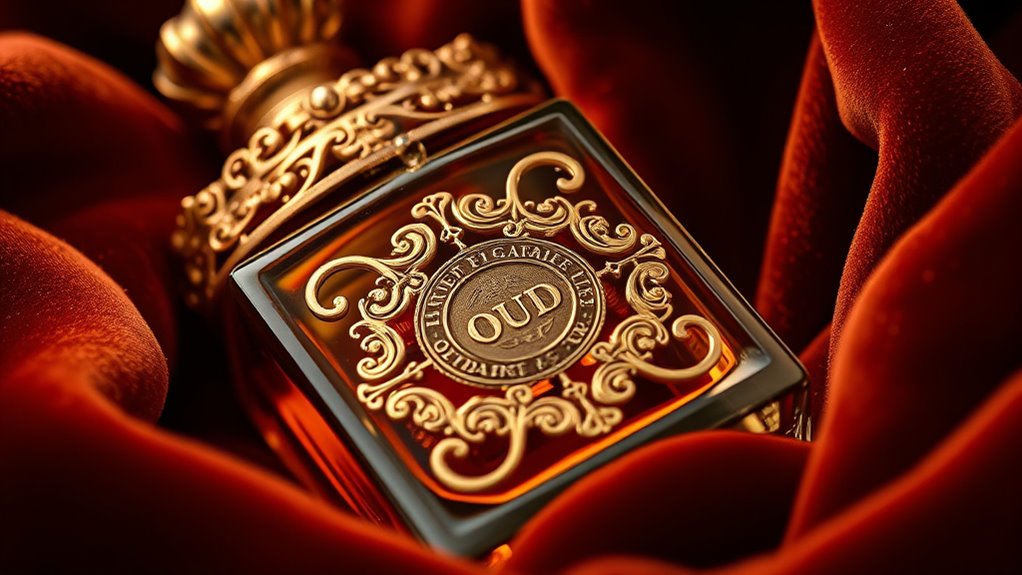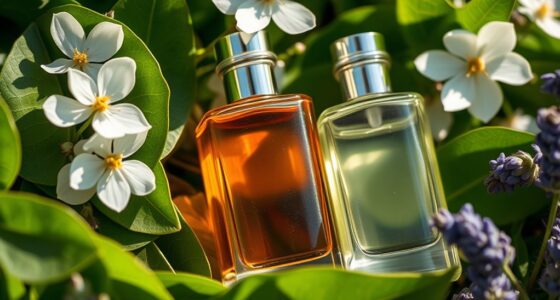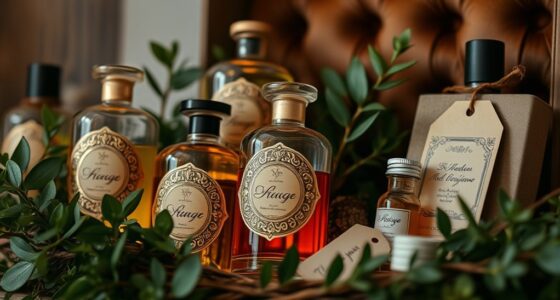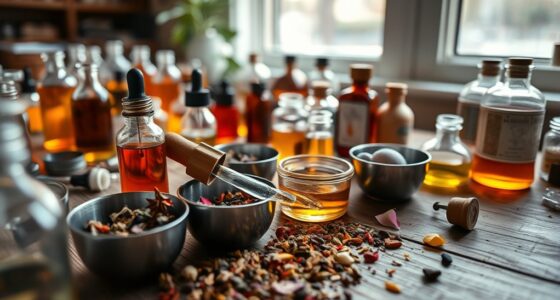Oud fragrances symbolize luxury with their deep, complex scents rooted in ancient traditions. Derived from agarwood, they feature warm, woody, and earthy notes that can range from sweet to smoky. Used in high-end perfumes, oud’s high cost comes from its rarity and labor-intensive extraction. You’ll find natural and synthetic options, each offering unique qualities. If you keep exploring, you’ll uncover more about what makes oud fragrances truly special.
Key Takeaways
- Oud is a rare, aromatic resin from Aquilaria trees, valued for its warm, woody, and complex scent profile.
- Natural oud offers a rich, authentic aroma with earthy, leathery, and smoky undertones, making it a luxurious fragrance base.
- Synthetic oud provides a sustainable, affordable alternative with similar woody notes, reducing environmental impact.
- Oud fragrances are long-lasting, often used as a base note to add depth and opulence to perfumes.
- The cultural significance and rarity of oud contribute to its status as a symbol of luxury in perfumery.
What Is Oud and Its Cultural Roots

Oud is a richly fragrant resin that comes from Aquilaria trees when they become infected by a specific mold. Known as agarwood, this aromatic resin forms as a defense mechanism, creating a highly valued fragrance. Its cultural roots run deep, especially in Middle Eastern culture, where oud holds spiritual significance. Traditionally, it’s used in religious rituals and ceremonies, symbolizing purification and divine connection. The term “oud” spans languages like Arabic, Sanskrit, and Persian, reflecting its historical importance across Asia and the Middle East. Because natural oud is rare and precious, its traditional use has persisted for thousands of years, embedding it firmly within various cultural practices. Additionally, sustainable harvesting of oud is increasingly emphasized to preserve these ancient traditions while minimizing environmental impact, ensuring that this sacred aroma continues to influence modern perfumery worldwide. Furthermore, ongoing research into cultivation techniques aims to meet the rising demand without depleting wild sources. Innovative restoration methods are also being developed to help rehabilitate overharvested forests and ensure the longevity of oud resources. Efforts to develop synthetic oud also contribute to reducing pressure on natural resources, helping to protect the environment and promote ethical sourcing.
The Unique Fragrance Profile of Oud
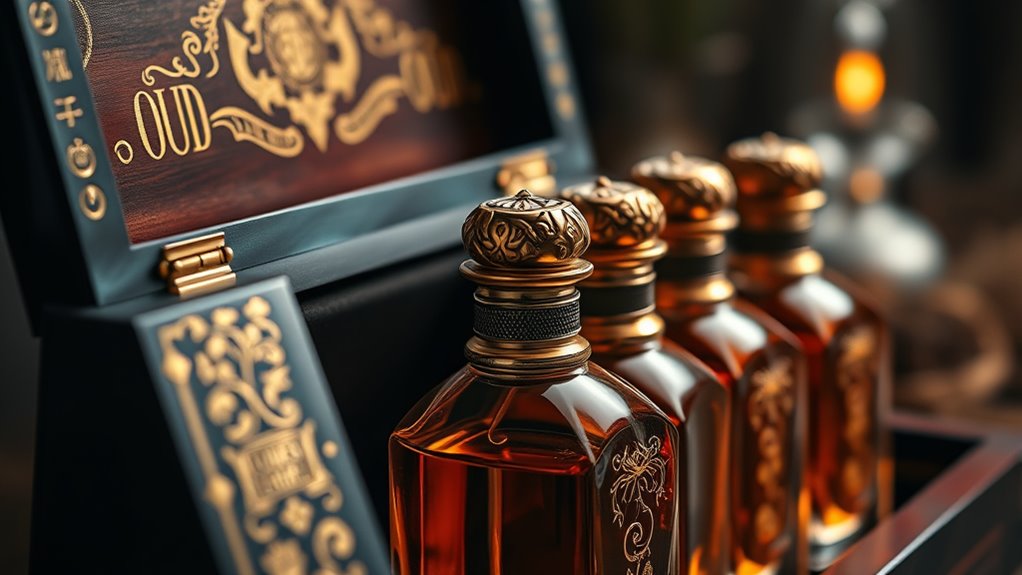
The fragrance profile of oud is as complex and layered as its rich history. You’ll notice its warm, woody notes intertwined with earthy undertones, creating a scent that’s both deep and inviting. Natural oud offers a rich, complex aroma that can include hints of leather, smoky elements, and animalic nuances, reminiscent of damp soil or dried hay. Its scent varies regionally, with some profiles being sweeter or smokier depending on the species and environment. Synthetic oud tends to be less animalic, often featuring sweeter, nuttier, or more subdued woody notes. When blended into perfume, oud pairs beautifully with sandalwood, vanilla, rose, or amber, enhancing its luxurious, multi-layered character and elevating its overall fragrance profile. Additionally, understanding AI technology can help in analyzing scent profiles and creating more refined fragrances.
How Oud Is Used in Modern Perfumes
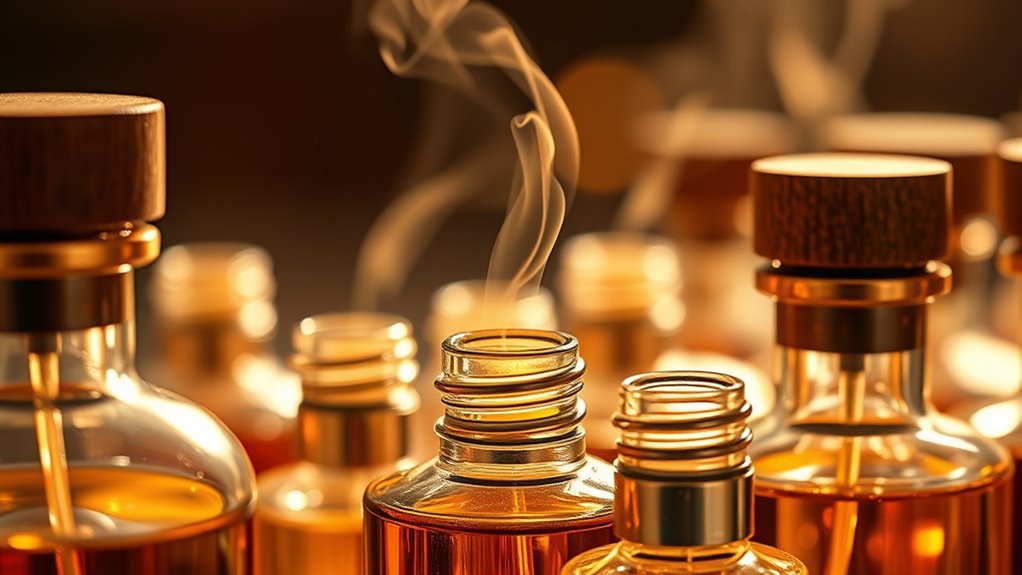
In modern perfumery, oud is prized as a powerful base note known for its longevity and depth. You’ll often find oud used in fragrance formulations as an essential oil, creating a rich, complex scent profile that anchors the perfume. Fragrance houses blend oud with other notes like sandalwood, rose, or amber to enhance its luxurious character. Oud’s versatility allows it to be incorporated in various formats, including chips, powders, or synthetic oud, which replicates its aroma while lowering costs and environmental impact. Its deep, woody aroma makes it ideal for layering with floral, fruity, or spicy notes, resulting in a sophisticated and enduring scent. Oud’s role as a base note ensures your perfume maintains its luxurious scent long after application. Recognizing angel numbers related to love and transformation can also influence how a perfume resonates emotionally, adding a spiritual dimension to your scent experience. Additionally, understanding the importance of scent layering can help in creating more nuanced and personalized fragrances.
The Reasons Behind Oud’s High Cost
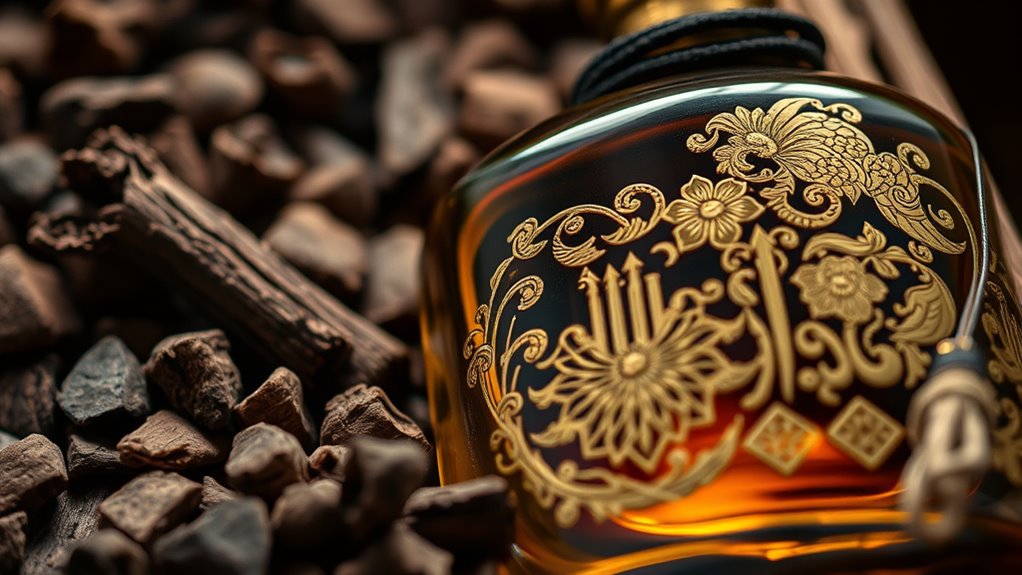
Natural oud commands a hefty price due to its extreme rarity and the complex process required to produce it. Only about 2-10% of wild agarwood trees develop the resin, making natural oud highly scarce. The resin formation occurs when infected trees are affected by mold over decades, often taking at least 25 years, which adds to the high cost. The extraction process is labor-intensive, involving careful hand carving and distillation to preserve quality. Additionally, environmental regulations limit sustainable sourcing, as overharvesting threatens certain agarwood species. These factors collectively drive the high cost of natural oud, with prices reaching up to $100,000 per kilogram. Its rarity, lengthy development, and strict harvesting practices all contribute to its status as a luxury ingredient. Understanding the importance of personal growth and development can help consumers appreciate the value of patience and sustainability in sourcing luxury products. Recognizing the importance of sustainable sourcing can promote responsible consumption and preservation of natural resources. Moreover, the intricate harvesting process highlights the necessity of supporting ethical practices within the luxury fragrance industry. This process also involves careful management to ensure ecological balance is maintained, preventing the depletion of wild agarwood populations. Furthermore, advances in refrigerant technology are exploring environmentally friendly options to reduce ecological impact.
Natural Versus Synthetic Oud: What’s the Difference?

While both natural and synthetic oud share a similar aromatic profile, their origins and qualities differ markedly. Natural oud comes from agarwood, producing oud oil through a lengthy, laborious process that captures its unique scent complexity. It’s rare, often costly, and has a rich, earthy, and animalic aroma that varies with each batch. Synthetic oud, on the other hand, is crafted from aromatic molecules designed to mimic natural oud’s scent profile. It offers a more consistent, cleaner aroma and allows perfumers greater control over scent development and longevity. Additionally, synthetic oud supports sustainability by reducing the overharvesting of raw materials. Renewable resources and the environmental impact of sourcing contribute to the increasing popularity of synthetic options. Although natural oud’s complexity is unmatched, synthetic versions provide an affordable, environmentally friendly alternative, making them popular in perfumery for achieving a desirable fragrance profile.
Popular Oud-Based Fragrances to Know
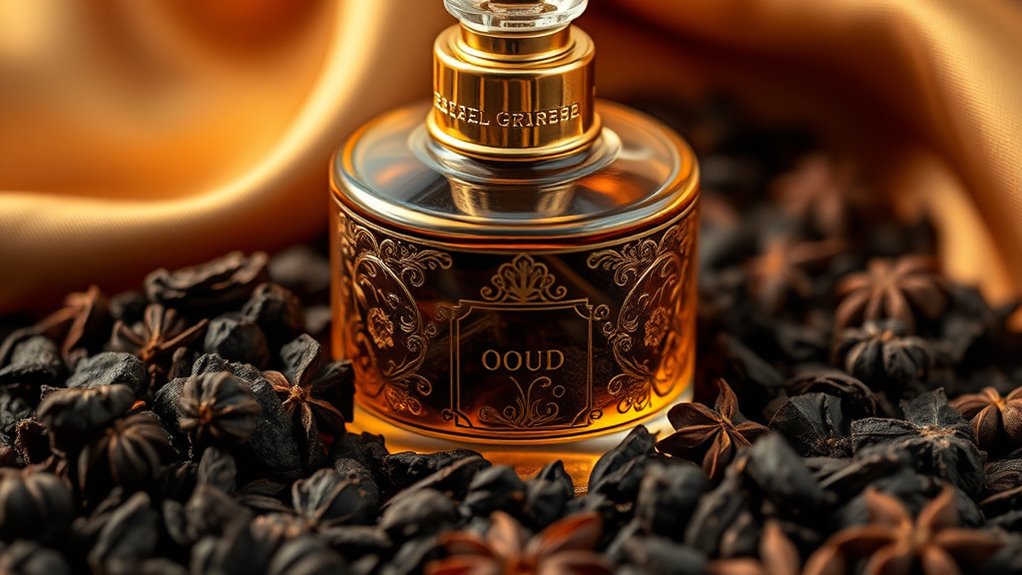
Oud has become a defining ingredient in luxury perfumery, with several iconic fragrances showcasing its rich complexity. Oud-based perfumes like Tom Ford Oud Wood helped popularize this scent in Western high-end perfumery, offering warm, woody notes that define luxury scent profiles. Other notable oud fragrances include Maison Francis Kurkdjian’s Oud Satin Mood, blending oud with floral notes like Bulgarian rose for an opulent feel. Armani Privé Oud Royal combines oud, amber, and spices, exemplifying the craftsmanship of oriental perfumes. Le Labo’s Oud 27 provides a smoky, abstract interpretation, appealing to niche fragrance lovers. The rise from 46 oud-centric launches in 2009 to 397 in 2019 underscores oud’s importance in the fragrance industry, cementing its signature oud in the world of high-end perfumery. Asset Division strategies can be applied to ensure a fair distribution of these luxurious fragrances during asset division processes. Additionally, beauty store hours have an impact on the availability of these exclusive fragrances for consumers. Understanding the market trends in oud fragrance popularity can also help consumers and brands stay ahead in this competitive segment. Moreover, the growing global entertainment industry has contributed to the rise in luxury fragrance demand, as celebrities and influencers often endorse these scents. Recognizing the luxury fragrance market and its evolving preferences is essential for both consumers and brands aiming to capitalize on oud’s enduring appeal.
The Future of Oud in the World of Perfumery
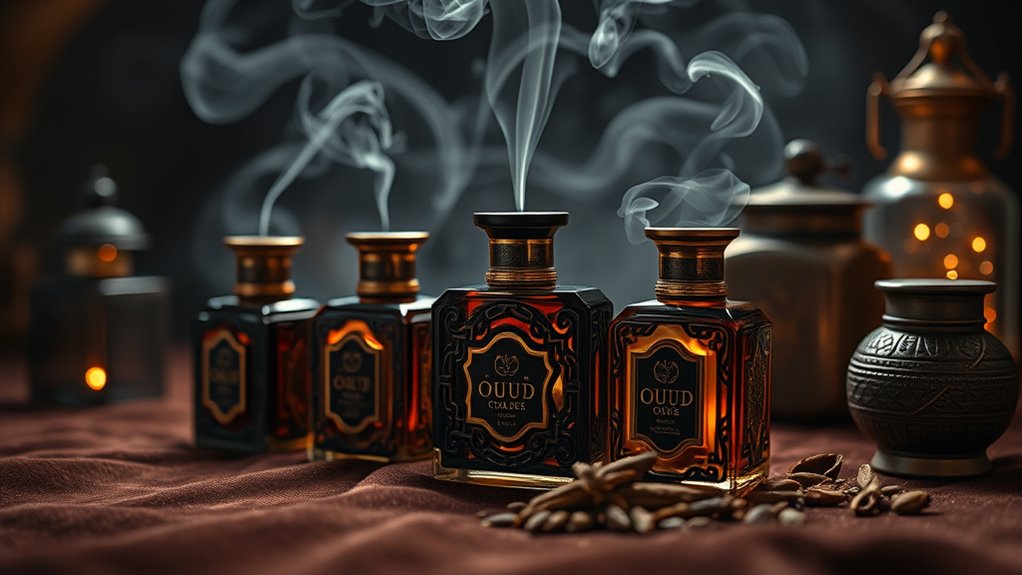
As sustainability becomes a central concern in perfumery, the future of oud is shifting toward ethical sourcing and environmentally friendly practices. Synthetic oud is gaining prominence, allowing perfumers to recreate authentic scents without depleting rare natural resources. Innovations in biotech are driving the development of lab-grown oud, reducing environmental impact and offering a sustainable alternative to traditional harvesting. Ethical harvesting and conservation efforts are shaping the oud supply chain, ensuring the protection of endangered aquilaria trees. Consumer demand for eco-friendly fragrances encourages brands to prioritize transparency and certifications, making sustainable sourcing a key industry trend. Additionally, using renewable resources in fragrance production helps minimize environmental impact and promotes sustainable growth. For instance, sustainable harvesting methods are being adopted to balance preservation with commercial demand. As the fragrance industry advances, the integration of eco-friendly practices and innovative technologies, such as sustainable farming practices, promises a more responsible and sustainable future for oud in perfumery.
Frequently Asked Questions
How Do You Describe Oud Scent?
You might describe oud scent as warm, woody, and complex, with earthy, resinous, and slightly sweet undertones. You’ll notice a musky, animalic aroma reminiscent of damp soil or forest floors. Depending on the type, it can also have smoky, leathery, or nutty notes, creating a luxurious and mysterious vibe. Synthetic oud tends to be softer and more floral, while natural oud feels richer, deeper, and more opulent, embodying sensuality and depth.
What Makes a Fragrance Luxury?
Imagine holding a rare gem in your hand—that’s what makes a fragrance luxury. It’s about using exclusive, high-quality ingredients like natural oud, which costs a fortune and symbolizes rarity. You’ll notice complex, layered notes that tell a story of craftsmanship and exclusivity. Limited editions and long-lasting scents elevate the experience, making you feel special. A luxury fragrance isn’t just a smell; it’s an emblem of prestige and refined taste.
What Is the Difference Between Oud and Regular Perfume?
The key difference between oud and regular perfume is that oud uses a natural, resinous extract from infected agarwood trees, giving it a deep, woody, and smoky scent. Regular perfumes often use synthetic or blended oils, offering a broader range of floral, citrus, or fresh notes. Oud fragrances are more intense, long-lasting, and expensive, reflecting their cultural importance and luxury status compared to more accessible, mass-produced regular perfumes.
Which Is the Best Oud Perfume in the World?
You’re wondering which is the best oud perfume in the world. While preferences vary, many consider Maison Francis Kurkdjian Oud Satin Mood a top contender due to its luxurious blend of oud, floral, and berry notes. Others might favor Tom Ford’s Oud Wood for its smoky, woody profile or Clive Christian’s Black Oud for its exclusivity. Ultimately, the best depends on your personal taste and style.
Conclusion
Now that you know what makes oud so special, you can appreciate its rich history, unique scent, and luxurious appeal. You understand how it’s crafted, why it commands high prices, and how it’s evolving in modern perfumery. Whether you prefer natural or synthetic, oud offers a world of depth, elegance, and tradition. Embrace its mystery, explore its versatility, and let its timeless charm elevate your fragrance collection. Oud isn’t just a scent; it’s an experience waiting to be discovered.
